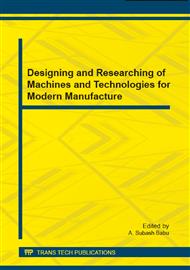[1]
Chong Un Pyon, Ji Young Woob, Sang Chan Park. Intelligent service quality management system based on analysis and forecast of VOC, Expert Systems with Applications. 2010, 37, pp.1056-1064.
DOI: 10.1016/j.eswa.2009.06.066
Google Scholar
[2]
Karl Luce, Lucie Trepanier, Fred Ciochetto, Lawrence Goldman SIMULATION AND OPTIMIZATION AS EFFECTIVE DFSS TOOLS,. Proceedings of the 2005 Winter Simulation Conference, Dec. 2005, p.1993-(1999).
DOI: 10.1109/wsc.2005.1574478
Google Scholar
[3]
Omera Khan, Martin Christopher, Alessandro Creazza. Aligning product design with supply chain: a case study,. Supply Chain Management: An International Journal, Vol. 17, No. 3, 2012, pp.323-336.
DOI: 10.1108/13598541211227144
Google Scholar
[4]
E. V. Gijoa, Johny Scariab, Jiju Antonyc. Application of Six Sigma Methodology to Reduce Defects of a Grinding Process,. International Quality and Reliability Engineering, May, 2011, pp.1221-1234.
DOI: 10.1002/qre.1212
Google Scholar
[5]
Karim Moustaghfir. The dynamics of knowledge assets and their link with firm performance,. MEASURING BUSINESS EXCELLENCE, Vol. 12, No. 2, 2008, pp.10-24.
DOI: 10.1108/13683040810881162
Google Scholar
[6]
David M. Ferrin, Martin J. Miller, David Muthler. Lean Sigma And Simulation, so What's the Correlation? V2,. Proceedings of the 2005 Winter Simulation Conference, Dec. 2005, p.2011-(2015).
DOI: 10.1109/wsc.2005.1574481
Google Scholar
[7]
Yun-na Liu, Kang Li. Application of Six Sigma Methodology DMAIC in HR Project Management-A Case Study of Motorola SC HR DSS Project,. 2011 IEEE 18th International Conference on Industrial Engineering and Engineering Management, Sep. 2011, pp.1340-1343.
DOI: 10.1109/icieem.2011.6035403
Google Scholar
[8]
Bob Little. Six Sigma techniques improve the quality of e-learning,. Industrial and Commercial Training, Vol. 35, No. 3, 2003, pp.104-108.
DOI: 10.1108/00197850310470320
Google Scholar
[9]
He Zhen, Qi Ershi, Liu Zixian. QUALITY IMPROVEMENT THROUGH SPC/DOE IN SMT MANUFACTURING,. Proceedings of the ICMIT 2000 Conference, Nov. 2000, pp.855-858.
DOI: 10.1109/icmit.2000.916817
Google Scholar
[10]
Salah Haridy, Sherif Araby Gouda, Zhang Wu. An Integrated Framework of Statistical Process Control and Design of Experiments for Optimizing Wire Electrochemical Turning Process,. International Journal of Advanced Manufacturing Technology, vol. 53, n1-4, Mar. 2011, pp.191-207.
DOI: 10.1007/s00170-010-2828-7
Google Scholar
[11]
Tan Phong Nguyen, Nidal Hilal, and Nicholas P. Hankins. Operating Conditions Corresponding to Optimal Final Properties of Activated Sludge Using the DOE and RSM Techniques,. Separation Science and echnology, 2009, 44: p.2041-(2066).
DOI: 10.1080/01496390902881303
Google Scholar
[12]
Deniz Bas, Ismail H. Boyac. Modeling and optimization I: Usability of response surface methodology,. Journal of Food Engineering, 2007, 78, pp.836-845.
Google Scholar


